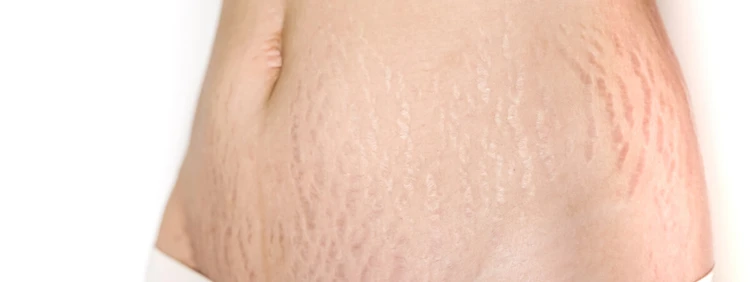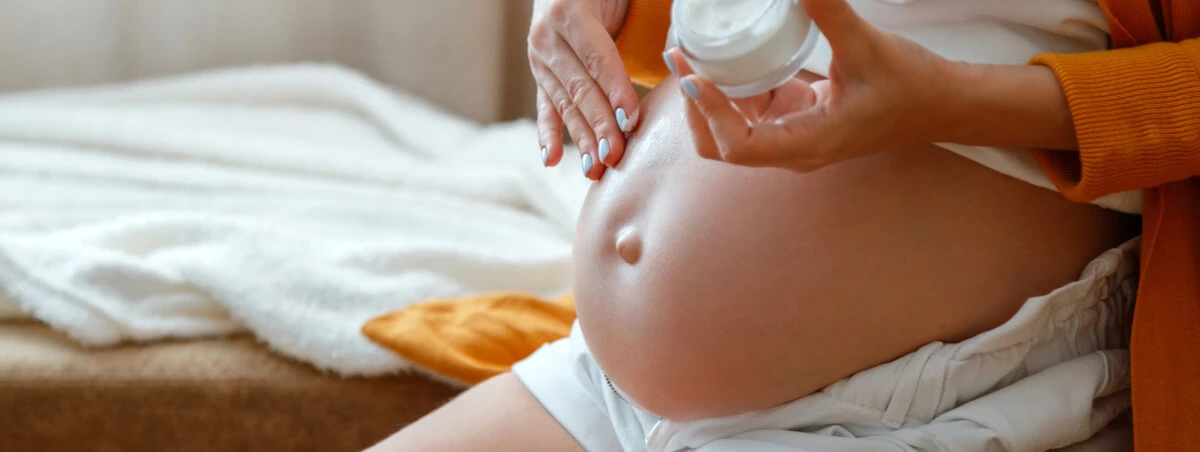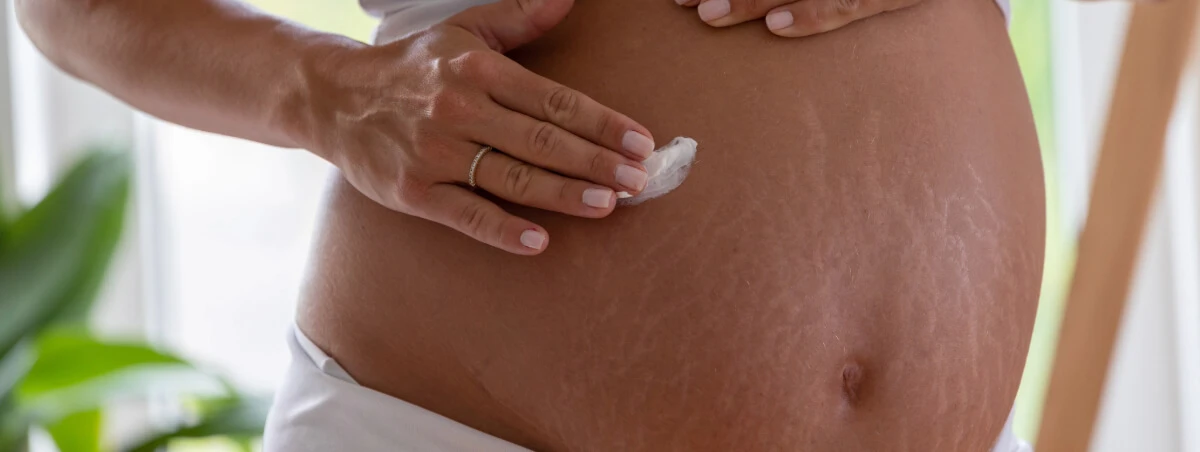You want to know what causes stretch marks? Life.
Life causes stretch marks.
And there’s nothing intrinsically harmful or ‒ as media of all forms would have us believe ‒ “ugly” about them.
Stretch marks are a signifier of change and growth — something we as a culture seem to dislike mainly on women’s bodies (for no reason).
Maybe it’s time we interrupted this chauvinistic narrative.
(That being said, if you have stretch marks and you’re not into them, also fine. You get to feel whatever you feel about your body. With. No. Shame.)
So what causes stretch marks? Can you prevent them? Can you treat them? Do you even want to try?
Let’s talk about it.
In this article: 📝
- What are stretch marks?
- What is the reason for getting stretch marks?
- How to get rid of stretch marks
What are stretch marks?
Stretch marks are scars that appear when your skin is quite literally stretched thin.
They can pop up in various places on your body — your butt, your thighs, your abs, your breast, your hips, your arms, pretty much anywhere.
Stretch marks are usually not painful, and can just be a part of growing up, getting pregnant, or your body changing for whatever reason.
Technically, stretch marks are defined as a scar on your body from skin expanding quickly.
The abrupt stretching of the skin disrupts the collagen and elastin of the skin layer which supports the skin.
As the skin heals, it results in a scar.

What do stretch marks look like?
Stretch marks can be like a rainbow on your skin ‒ beautiful, really.
They emerge as a pattern of parallel(ish) squiggles and are available in a full palette of colors, from blue to purple to pinkish to grey to silver, or a different shade of your natural skin tone.
They can also appear in different shades on different skin tones.
On darker skin tones, stretch marks can appear darker brown or purplish in color, but they can also be silvery-white.
On lighter skin tones, they can be pink, silvery-white, purple, blue, or red.
What is the reason for getting stretch marks?
Stretch marks are a sign of change in your body. [1]
So how do stretch marks form?
Pregnancy is a big catalyst.
So is puberty.
They can also occur if you gain or lose a lot of weight quickly.
Another reason? Serious weight training that causes your muscles to get bigger, fast.
In rare cases, stretch marks can be caused by a medical condition like Marfan syndrome, which affects connective tissue. [2]

What are different types of stretch marks?
Stretch marks go by variations of the Latin term striae, meaning “furrows”:
Striae gravidarum are the stretch marks that come after pregnancy.
Striae distensae is a catch-all term for the stretch marks that make their debut outside of pregnancy.
Then you also have striae rubrae, the pinkish-reddish type, and striae albae, the white ones.
If your stretch mark is red, it probably formed more recently and might be more responsive to some forms of treatment.
There are also striae caerulea, which are darker blue stretch marks, and striae nigra, which are black-colored stretch marks, like the linea nigra.
What causes stretch marks on thighs?
Stretch marks on thighs are very common among men, women, and non-binary people of all body types.
They usually happen during puberty, but could be during any time when your thighs change size rapidly ‒ like if you’re gaining weight or muscle.
What causes stretch marks on buttocks?
Stretch marks on the butt are more common among women’s bodies, owing to larger fat deposits that grow during puberty.
But, like stretch marks anywhere else on your body, they can appear on any body type, male, female, in-between, or neither.
What causes stretch marks on breasts?
Stretch marks on breasts generally happen either during puberty or pregnancy, but can be at any time that your breasts grow in size.
What causes stretch marks on arms?
Stretch marks on arms are a bit less common than the others, but can be caused by the same things: puberty, pregnancy, and weight gain.
It is often more commonly seen in men when they start weight training and grow muscle mass rapidly.
What causes stretch marks on hips?
Stretch marks on hips are also quite common among men, women, and non-binary people.
Again, they can be caused by puberty, pregnancy, or weight gain.
What causes stretch marks during pregnancy?
During pregnancy, your body goes through many changes.
One of these changes is that your body will grow bigger ‒ it has to accommodate a baby, after all!
So with this quick growth, it’s pretty much expected that you’ll see stretch marks appear, particularly around your growing bump, breasts, and hips.

How to get rid of stretch marks
Okay, we get it ‒ if you’re not a fan of this body accessory, that’s totally fine.
You’re not alone, either ‒ many people aren’t keen on their stretch marks.
But that doesn’t mean many people don’t celebrate them!
Nevertheless, let’s explore ways to minimize or get rid of them.
Do stretch marks go away?
As we mentioned earlier, stretch marks are scars.
Meaning they’re permanent.
Sometimes they lighten.
Sometimes they appear to fade completely.
And sometimes they stubbornly stick around in all their glory as a permanent fixture.
How to treat stretch marks
There are a bunch of treatments on the market.
They start on the low end of the price spectrum (creams and gels) to the high end (cosmetic surgery).
Real talk: treatment for stretch marks is not always effective.
In fact, no one treatment has been proven to work across the board.
That’s right—a cure-all for stretch marks is yet to be found.
If your stretch marks are driving you nuts, one option is to apply self-tan to diminish their appearance.
This is just a tip many people have offered but has no medical bearing.
Make-up can work too.
And while you’re doing whatever you’re doing or not doing, join us in changing up the narrative.
Rather than call them harmless but unsightly, let’s just call them harmless.
Those stretch marks are a sign of transition—the marks you get as you move from one end of one chapter to another.
Try — even just an exercise, just for today — to love them.
How can stretch marks be prevented?
So, here’s the deal: stretch marks can’t really be prevented.
They happen.
And they’re more likely to happen if they run in your family.
Keeping hydrated and eating a nutrient-rich diet might help stave them off, but there are no guarantees.
Some people swear by various lotions and creams, but these aren’t proven to work either.
In any case, treating yourself to healthy food and lots of water and massaging your belly with lotion are good self-care to-do’s, stretch marks or not.
So now we know what causes stretch marks, let’s change the narrative around them.
Stretch marks are a fact of life.
Pretty much everyone gets them, so why the stigma?
If you want to, wear your stretch marks with pride!

